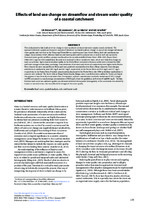| dc.contributor.author | Petersen, C.R. | |
| dc.contributor.author | Jovanovic, Nebo Z. | |
| dc.contributor.author | Le Maitre, D.C. | |
| dc.contributor.author | Grenfell, Michael | |
| dc.date.accessioned | 2017-03-13T07:46:21Z | |
| dc.date.available | 2017-03-13T07:46:21Z | |
| dc.date.issued | 2017 | |
| dc.identifier.citation | Petersen, C.R. et al. (2017). Effects of land use change on streamflow and stream water quality of a coastal catchment. Water SA, 43(1): 139-152 | en_US |
| dc.identifier.issn | 0378-4738 | |
| dc.identifier.uri | http://hdl.handle.net/10566/2626 | |
| dc.identifier.uri | http://dx.doi.org/10.4314/wsa.v43i1.16 | |
| dc.description.abstract | This study aimed to link land cover/use change to water quality in an important water supply coastal catchment. The approach followed a spatial and temporal analysis of historical catchment land use change to assess how changes influenced water quality and river flow in the Touws and Duiwe Rivers, southwestern Cape, South Africa. Each sub-catchment has unique characteristics which influence land use and water quality and the purpose was to analyse each one separately. Historical water quality and flow analysis were based on the records available (Duiwe River: 1998-2013; Touws River: 1980-2013) together with rainfall data. Records were analysed to detect trends over time, which were linked to changes in land use activities. Agriculture intensified rapidly in the Duiwe River catchment with most arable land cultivated by 1960 and water storage as farm dams escalating. Concentrations of nutrients and electrical conductivity were higher in the Duiwe River than in the more natural Touws River, and were positively correlated to river flows. Mean values for total nitrogen and electrical conductivity were 0.03 mg/L and 16.7 mg/L, respectively, in the Touws River and 0.25 mg/L and 127 mg/L, respectively, in the Duiwe River. Nutrient concentrations decreased in the Duiwe River after 2006 as fertilizer applications to pastures were reduced. The South African Target Water Quality Ranges were exceeded at times and in the Touws catchment this appears to have been due to extensive fires. For instance, sodium concentrations reached a maximum of 1 874.5 mg/L in 1996 compared to a usual average concentration of 20.8 mg/L where the guidelines are between 0 and100 mg/L. The link between land cover/use and water quality was demonstrated and when spatial heterogeneity of the catchments was altered by human or natural events, this was reflected in changes in the water quality. | en_US |
| dc.language.iso | en | en_US |
| dc.publisher | South African Water Research Commission | en_US |
| dc.rights | Water S.A. is an Open Access journal. This article is published under a Creative Commons Attribution Licence (CC BY 4.0) | |
| dc.subject | Land cover | en_US |
| dc.subject | Spatial analysis | en_US |
| dc.subject | Sub-catchment scale | en_US |
| dc.title | Effects of land use change on streamflow and stream water quality of a coastal catchment | en_US |
| dc.type | Article | en_US |
| dc.privacy.showsubmitter | FALSE | |
| dc.status.ispeerreviewed | TRUE | |
| dc.description.accreditation | ISI | en_US |

